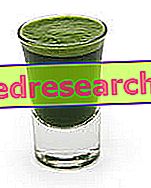Chlorophyll is a green pigment present in almost all plants, in algae and in some bacteria; has the purpose of absorbing the light necessary for the synthesis of carbohydrates, which occurs starting from water and carbon dioxide (chlorophyll photosynthesis).

Since chlorophylls mainly absorb light in the blue-violet and orange-red portion, and little green light, the latter is transmitted to our eyes, which pick up the typical emerald color.
A very important component of the chlorophyll molecule is magnesium; it is not surprising, therefore, that the content of this mineral in green vegetables is quite generous.
Chlorophyll extracted from plants is used as a colorant for food and pharmaceutical products; many green tablets are coated with chlorophyll, just as the color of olive oil can easily be enhanced by the addition of these pigments (in certain food frauds it is used to mask cuts with lower quality oils, such as hazelnut). The presence of chlorophyll in a dietary supplement, in a dietetic product or in a drug can still have a functional significance, since the substance has antioxidant and anti-anemic properties (chlorophyll has a porphyrin structure very similar to that of hemoglobin, from which it differs in the presence of magnesium rather than iron in the center of the tetrapyrrolic ring).
In fresh vegetables (especially in spinach, rocket, parsley and green beans), chlorophyll contributes - along with polyphenols and carotenoids - to give the food antioxidant and protective virtues (it becomes complex, for example, with carcinogens, such as aromatic hydrocarbons found in tobacco smoke or certain heterocyclic amines present in burnt meat, reducing their absorption at the gastrointestinal level).
Chlorophyll or its semi-synthetic derivative, chlorophyllin, are used as an active ingredient in some preparations intended to reduce body odors, in particular that of urine (in incontinent subjects) and faeces (in patients who have undergone colostomy or ileostomy, i.e. the creation, through surgery, of an artificial anus in the abdomen).



